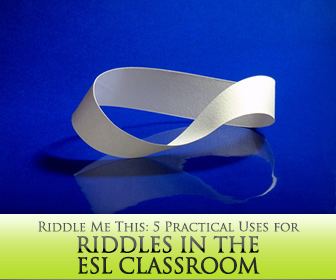Why did the ESL teacher use riddles in the classroom?
Well, I suppose you could answer that question several ways. Riddles aren’t something that most English as a second language teachers immediately go to for classroom work. At first glance, the humor in them doesn’t often reach across language barriers. We may like riddles personally and find them funny, but using them in the classroom? How does an ESL teacher translate the humor from one culture to another? How can we get our students to get riddles? Why bother bringing riddles into the ESL classroom at all? Don’t give up. Introducing your students to riddles and using them in language study is actually easier than you think, and riddles can be a valuable resource to the ESL teachers who are willing to use them. Here are some practical uses for riddles in your ESL class.

5 Practical Uses for Riddles in Your ESL Classroom
-
1
Group Discussion
Why did the chicken cross the road? Depending on where your students call home, they may have all sorts of ideas. Though riddles are intended to be humorous and depend on word play, that doesn’t mean you and your students can’t take a little literal break when it comes to these silly questions. When you introduce a riddle to your class, let groups of students talk for a few minutes about what the answer might be. Encourage your students to think both about the humorous answer as well as a more serious one. Then, have groups of students share their ideas with each other. Though the ultimate intention of riddles is humor, these questions can function as good conversation starters and get your students sharing ideas and using language in the classroom with each other.
-
2
Teaching Homophones
In one typical riddle structure, the solutions to riddles depend on an alternate meaning of a key word in the question. For example, “What has four wheels and flies?” One’s natural instinct is to imagine a type of vehicle that fits the description. Planes? Helicopters? Something else? When you do, though, you won’t come up with the “right” answer to the question. That’s because this riddle is based on two different meanings of the word fly. Because of how it’s worded, the question makes the listener picture the motion of flying, but the answer depends on another meaning of the word. Rather than the action of flying, this riddle is asking about the insect called a fly. The correct answer to this riddle depends on using the noun form of fly. When they do, your students may come up with the correct answer to the riddle on their own: a garbage truck. A similar riddle is this: What is black and white and red all over? Or should we say read all over? The answer is a newspaper, and your ESL student must know the two distinct words (red and read) that sound alike in English. Once your students understand how homophones are used in riddles, you can challenge them to write their own riddles that depend on two different meanings of one word.
-
3
Teaching Idiomatic Expressions
Another common theme among riddle answers is literal versus idiomatic meanings. When the riddle is “Why did the man throw the clock out the window?” we are imagining a literal interpretation of events. We see the man taking his alarm clock and throwing it out the window, which we all might want to do on Monday mornings. The key here, though, is the idiomatic expression that answers the riddle. He wanted to see time fly. The man in the riddle is acting out a literal depiction of an idiomatic expression. ESL students spend much time learning English’s idioms. A fun way to review them is to use this type of riddle in your classroom. Once your students know a good pool of idioms, challenge them to write their own riddles using one of those expressions with a literal expression!
-
4
Punctuation in Dialogue
Punctuating dialogue can be confusing. I have spent many class periods instructing students in the proper use of quotation marks, commas, and speech tags. The next time you do the same, you can use riddles to make the practice more interesting with the classic riddle genre – knock-knock jokes. Because every knock-knock is a conversation between two people, writing them out is a simple way to give your students practicing writing dialogue, and you’ll get the opportunity to talk about homophones, idioms and cultural humor as well.
-
5
Don’t Forget About Fun
Why do young and old ultimately like riddles? Because they are fun. Riddles do have practical applications in the ESL classroom, but the benefits of riddles aren’t all academic. Sometimes the best thing you can do in your classroom is encourage a little laughter. Working with riddles gives your students a chance to be creative and witty as they study and learn the English language and hopefully gets everyone in the room chuckling, too!
So why did the ESL teacher use riddles in the classroom? What do you think?
P.S. If you enjoyed this article, please help spread it by clicking one of those sharing buttons below. And if you are interested in more, you should follow our Facebook page where we share more about creative, non-boring ways to teach English.







